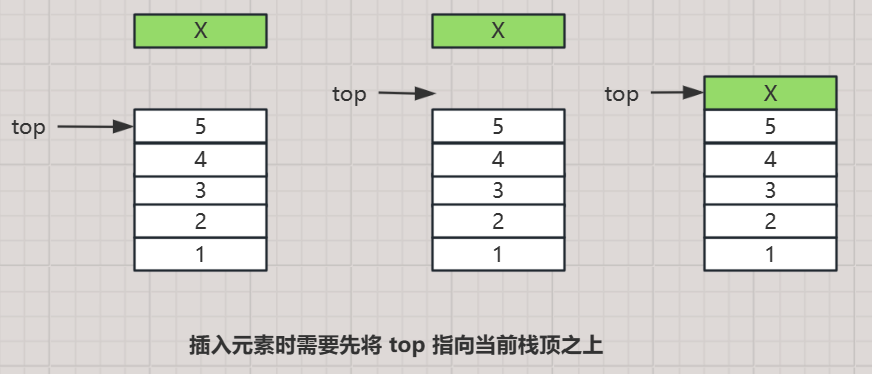-
【数据结构初阶(4)】栈的基本操作实现
Ⅰ 概念及结构
1. 栈的概念
- 栈:栈是一种特殊的线性表,其只允许在固定的一端进行插入和删除元素操作。
- 栈顶和栈底:进行数据插入和删除操作的一端称为栈顶,另一端称为栈底。栈中的数据元素遵守后进先出的原则
- 空栈:不含任何元素的栈
2. 栈的操作
- 入栈:在栈顶插入数据称为入栈 (压栈 / 进栈),入数据在栈顶。
- 出栈:在栈顶删除数据称为出栈 (弹栈),出数据在栈顶。

Ⅱ 基本操作实现
1. 栈的定义
- 栈一般用数组或链表来实现,使用数组栈在入栈上会更轻松,因此本文使用的为数组栈 (顺序栈)。
代码实现
// 支持动态增长的栈 typedef int STDataType; typedef struct stack { STDataType* data; //栈空间 int top; //栈顶 int capacity; //容量 }stack;- 1
- 2
- 3
- 4
- 5
- 6
- 7
- 8
- 9
2. 初始化栈
实现方法
先将栈空间置空,栈顶置为 -1,栈空间容量置为 0。
- 栈顶置为 -1,表示指向当前元素。因为本文使用的为数组栈,栈顶实际上是最后一个元素的下标,如果栈顶初始化为 0 的话,就没法很好的表示栈内是没有元素还是只有一个元素。
代码实现
// 初始化栈 void StackInit(stack* ps) { assert(ps); ps->data = NULL; //栈空间置空 ps->top = -1; //栈顶 ps->capacity = 0; }- 1
- 2
- 3
- 4
- 5
- 6
- 7
- 8
- 9
3. 元素入栈
- 栈顶指针 top 指向的是当前的元素,在插入新元素时需要先将栈顶指针 + 1,指向栈顶之上。

代码实现
// 入栈 void StackPush(stack* ps, STDataType data) { assert(ps); if (ps->top + 1 == ps->capacity) //检查栈空间是否需要扩容 { int newcapacity = ps->capacity == 0 ? 4 : 2 * ps->capacity; STDataType* tmp = (STDataType*)realloc(ps->data, sizeof(STDataType) * newcapacity); if (NULL == tmp) { perror("realloc"); exit(-1); } ps->data = tmp; ps->capacity = newcapacity; } ps->top++; //栈顶指针指向栈顶之上 ps->data[ps->top] = data; //元素入栈 }- 1
- 2
- 3
- 4
- 5
- 6
- 7
- 8
- 9
- 10
- 11
- 12
- 13
- 14
- 15
- 16
- 17
- 18
- 19
- 20
- 21
- 22
- 23
- 24
- 25
4. 元素出栈
- 若栈不为空,则直接将栈顶指针 - 1 即可,只有在栈顶指针维护下的元素才是有效数据。
// 出栈 void StackPop(stack* ps) { assert(ps); assert(ps->top > -1); //栈不为空 ps->top--; //栈顶指针 - 1 }- 1
- 2
- 3
- 4
- 5
- 6
- 7
- 8
5. 获取栈顶元素
- 若栈不为空,则直接返回栈顶指针指向的那块空间的数据即可。
// 获取栈顶元素 STDataType StackTop(stack* ps) { assert(ps); assert(ps->top > -1); //栈不为空 return ps->data[ps->top]; //返回栈顶元素 }- 1
- 2
- 3
- 4
- 5
- 6
- 7
- 8
6. 获取栈中有效元素个数
- 因为栈顶指针实际表示的是数组下标,所以栈中有效数据的个数为 top+1。
// 获取栈中有效元素个数 int StackSize(stack* ps) { assert(ps); return ps->top + 1; }- 1
- 2
- 3
- 4
- 5
- 6
- 7
7. 判断栈空
- 在初始化栈时将栈顶指针初始化为 -1表示栈空,可以直接用 -1 是否等于 top 来判断是否栈空。
// 检测栈是否为空,如果为空返回非零结果,如果不为空返回0 int StackEmpty(stack* ps) { assert(ps); return -1 == ps->top; }- 1
- 2
- 3
- 4
- 5
- 6
- 7
8. 销毁栈
// 销毁栈 void StackDestroy(stack* ps) { assert(ps); free(ps->data); //释放栈空间 ps->data = NULL; ps->top = ps->capacity = 0; }- 1
- 2
- 3
- 4
- 5
- 6
- 7
- 8
- 9
-
相关阅读:
Feng Office 3.7.0.5 - 文件上传
可视化交互工具 Dreamview
记录一次Golang逃逸分析
C国演义 [第十二章]
『亚马逊云科技产品测评』活动征文|借助AWS EC2搭建服务器群组运维系统Zabbix+spug
React 中图片请求失败使用裂图
14.Java RMI学习以及制作远程服务
利用Qt实现可视化科学计算器
Elasticsearch(ES)简介及基本使用
vue2.x与vue3.x中自定义指令详解
- 原文地址:https://blog.csdn.net/shangguanxiu/article/details/134544885
